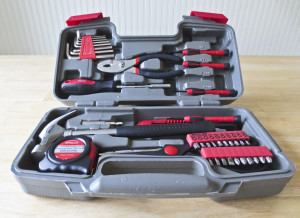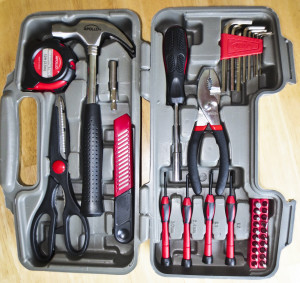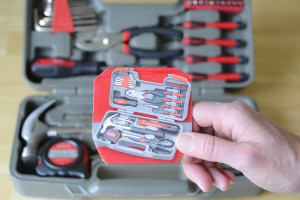The Functional Toolbox posts explore how we could use functional, real-life items in speech therapy, to exercise language or cognitive skills, or practice strategies that improve function. Some patients have a negative reaction to worksheets, so using functional, tangible items is another vehicle we can use to target patient-centered goals or strategies.
Affiliate links from Amazon are included to link the exact items I use. Thank you for considering using these links as a way to support the efforts of Honeycomb Speech Therapy.
Toolbox Item: Tool Kit!
I ordered this toolkit from Amazon because it had the best variety of tools for the lowest cost!
For YOU:
I created a “Product Information” Sheet, “Product Reviews”, and pictures that may be helpful in speech therapy with adults, depending on your goals! These are specific to the tool kit I ordered. Note: I used the packaging picture as a visual cue as needed to help patients figure out how to put them back in the case. I did remove the plastic knife for safety reasons.
Here you go! Tool Kit Info
Sample Therapy Ideas:
I hope these ideas are useful or help you easily target a patient-centered goal using a relevant topic! If you would like other ideas like this, please check out my Home Sweet Home Series.
| To Target Strategies or Skills in This Area: | The Patient Could Do This: |
| Verbal Expression | *Name tools
*Describe function of tools with project examples *Explain factors to look for when deciding what type and brand of tools to purchase |
| Written Expression | *Write tool “wish list”
*Write sentences to explain how each tool could be used in household tasks *Write a pros/cons letter for teaching basic tool use/home maintenance in high school curriculum |
| Auditory Comprehension | *Word-level identification of tool name in a field of 5 tools
*Use warranty information (read aloud) to challenge multi-sentence comp |
| Reading Comprehension | *Use written tool information to order the tools from least to most expensive
*Summarize the written reviews of product |
| Motor Speech | *Challenge ability to carry-over motor speech strategy or skill while explaining use, purpose, or how-to for a certain tool |
| Attention | *Sustain attention: Measure table or chair in SLP office and write down
*Alternate attention: Make a list of SLP office furniture dimensions throughout session, alternating with other therapy tasks in 5 minute intervals. *Divide attention: Figure out how to place tools back in tool box, or organize tools by size or price, while also listening to TED Talks, participating in conversation, or other language task |
| Memory | *Short-term recall for tool price, function, or review info (immediate or delayed), can add multiple units of info to increase complexity. |
| Thought Organization | *Organize a list of tools to purchase, in order of priority, for those with a small budget. What order would you recommend for those buying 1 at a time? (verbal or written) |
| Problem-Solving / Reasoning | *Non-verbal problem-solving: Solve how to place tools back in tool kit (provide picture as needed)
*Divergent problem-solving: Name multiple purposes for each tool. Name multiple locations to purchase tools. *Calculate money saved by buying tool kit together rather than individual tools *Explain or draw a map of home workshop / shed and best way to organize |
| Executive Function | *Evaluate strategy success during task, or plan how to adapt strategies for new situation.
*Plan home program task that could be a similar challenge |
| Pragmatics | *Use appropriate social language for a verbal task (Practice adjusting to situation: peers vs explaining to a customer vs store phone call).
*Use appropriate eye contact, facial expression, gestures for presentation. |
What else do you like to use in your “Functional Toolbox?”
If you want more ideas like this, check out the Home Sweet Home Series and previous Functional Toolbox posts (Garden Seed Packets).
Make sure you get the latest functional therapy updates: “Like” Honeycomb Speech Therapy on Facebook or Pinterest, or sign up for email updates.


I really enjoy your blog!
Thank you for all of the wonderful (and FUNCTIONAL!) ideas for tx!
Excellent ideas! Thank you!
Your blog is SO WONDERFUL!! Thank you for taking the time out of your busy schedule to make our lives easier.
Thanks, McLaine! I am happy to share!
When meeting with clients, I collaborate with family, friends, and staff to fill out a pie chart like the one pictured below, based on the wonderful work of Sarah Baar at Honeycomb Speech Therapy. This chart helps to generate personally relevant words for all therapy tasks. I want to know anything and everything of interest to the client. What makes them tick? What do they want to talk about? Fun facts? Favorite stories? Discovering motivating topics will increase the likelihood of carryover and use.
So true! Thanks for sharing!